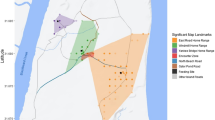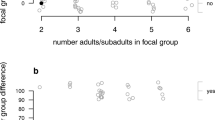Abstract
Evolutionary game theory posits that competitive ability affects the initiation of conflicts. When contests occur among groups, competitive ability is generally measured as the size of the group and larger groups are expected to win against smaller groups. However, in some cases, individual participation during intergroup conflicts appears unaffected by competitive ability. To test whether these instances might be due to an unduly strict definition of participation, I re-evaluate the responses of gray-cheeked mangabeys (Lophocebus albigena) to the calls of real and simulated neighboring groups. In contrast with previous analyses, I consider multiple measures of group size, treat movement responses as a continuous variable, and evaluate individual responses (N = 201 focal follows). Males made stronger approaches toward calling neighbors than females, though both sexes tended to retreat from groups that were <500 m away and to approach more distant neighbors. Individuals in small groups retreated while those in large groups both approached and retreated. There was no evidence of a collective action problem: in fact, approaches were more likely within large groups than small groups, and approaches were stronger when at least one other individual within the focal group made a dramatic approach toward the caller. The absence of a group size effect is attributable to coarse methods in some contexts and to a stronger effect of collective behavior or resource-related motivation in other contexts.



Similar content being viewed by others
References
Arlet, M. E., Molleman, F., & Chapman, C. A. (2007). Indications for female mate choice in wild groups of grey-cheeked mangabeys. Acta Ethologica, 10, 89–95.
Arlet, M. E., Molleman, F., & Chapman, C. A. (2008). Mating tactics in male grey-cheeked mangabeys (Lophocebus albigena). Ethology, 114, 851–862.
Arnott, G., & Elwood, R. W. (2009). Assessment of fighting ability in animal contests. Animal Behaviour, 77(5), 991–1004.
Batchelor, T. P., Santini, G., & Briffa, M. (2012). Size distribution and battles in wood ants: Group resource-holding potential is the sum of the individual parts. Animal Behaviour, 83(1), 111–117.
Brown, M. (2011). Intergroup encounters in grey-cheeked mangabeys (Lophocebus albigena) and redtail monkeys (Cercopithecus ascanius): form and function. [Ph.D.] New York, Columbia University. https://doi.org/10.7916/D8T159NZ.
Brown, M. (2013). Food and range defense in group-living primates. Animal Behaviour, 85(4), 807–816.
Brown, M. (2014). Patch occupation time predicts responses by grey-cheeked mangabeys (Lophocebus albigena) to real and simulated neighboring groups. International Journal of Primatology, 35(2), 491–508.
Brown, M., & Crofoot, M. C. (2013). Social and spatial relationships between primate groups. In E. Sterling, E. Bynum, & M. Blair (Eds.), Primate ecology and conservation: A handbook of techniques (pp. 151–176). Oxford: Oxford University Press.
Brown, M., & Waser, P. M. (2018). Group movements in response to competitors' calls indicate conflicts of interest between male and female grey-cheeked mangabeys. American Journal of Primatology, 80(11), e22918.
Burnham, K. P., & Anderson, D. R. (2002). Model selection and multimodel inference: A practical information-theoretic approach. New York: Springer Science+Business Media.
Burnham, K. P., Anderson, D. R., & Huyvaert, K. P. (2011). AIC model selection and multimodel inference in behavioral ecology: Some background, observations, and comparisons. Behavioral Ecology and Sociobiology, 65(1), 23–35.
Byrne, R. W., Whiten, A., & Henzi, P. (1987). One-male groups and intergroup interactions of mountain baboons. International Journal of Primatology, 8(6), 615–633.
Cords, M. (2002). Friendship among adult female blue monkeys (Cercopithecus mitis). Behaviour, 139(2–3), 291–314.
Crofoot, M. C., & Gilby, I. C. (2012). Cheating monkeys undermine group strength in enemy territory. Proceedings of the National Academy of Sciences of the USA, 109(2), 501–505.
Elwood, R. W., & Arnott, G. (2012). Understanding how animals fight with Lloyd Morgan's canon. Animal Behaviour, 84(5), 1095–1102.
Elwood, R. W., & Arnott, G. (2013). Assessments in contests are frequently assumed to be complex when simple explanations will suffice. Animal Behaviour, 86(5), e8–e12.
Enquist, M., & Leimar, O. (1987). Evolution of fighting behavior: The effect of variation in resource value. Journal of Theoretical Biology, 127(2), 187–205.
Fashing, P. J. (2001). Male and female strategies during intergroup encounters in guerezas (Colobus guereza): Evidence for resource defense mediated through males and a comparison with other primates. Behavioral Ecology and Sociobiology, 50, 219–230.
Gelman, A. (2008). Scaling regression inputs by dividing by two standard deviations. Statistics in medicine, 27(15), 2865–2873.
Harris, T. R. (2010). Multiple resource values and fighting ability measures influence intergroup conflict in guerezas (Colobus guereza). Animal Behaviour, 79(1), 89–98.
Harris, T. R., & Monfort, S. L. (2003). Behavioral and endocrine dynamics associated with infanticide in a black and white colobus monkey (Colobus guereza). American Journal of Primatology, 61, 135–142.
Hawkes, K. (1992). Sharing and collective action. In E. A. Smith & B. Winterhalder (Eds.), Foundations of human behavior: Evolutionary ecology and human behavior (pp. 269–300). Hawthorne: Aldine de Gruyter.
Heinsohn, R., & Packer, C. (1995). Complex cooperative strategies in group-territorial African lions. Science, 269(5228), 1260–1262.
Hopkins, M. E. (2013). Relative dominance and resource availability mediate mantled howler (Alouatta palliata) spatial responses to neighbors' loud calls. International Journal of Primatology, 34, 1032–1054.
Hurd, P. L. (2006). Resource holding potential, subjective resource value, and game theoretical models of aggressiveness signalling. Journal of Theoretical Biology, 241(3), 639–648.
Kitchen, D. M., & Beehner, J. C. (2007). Factors affecting individual participation in group-level aggression among non-human primates. Behaviour, 144, 1551–1581.
Langergraber, K. E., Watts, D. P., Vigilant, L., & Mitani, J. C. (2017). Group augmentation, collective action, and territorial boundary patrols by male chimpanzees. Proceedings of the National Academy of Sciences of the USA, 114(28), 7337–7342.
Lazaro-Perea, C. (2001). Intergroup interactions in wild common marmosets, Callithrix jacchus: Territorial defence and assessment of neighbours. Animal Behaviour, 62(1), 11–21.
Markham, A. C., Alberts, S. C., & Altmann, J. (2012). Intergroup conflict: Ecological predictors of winning and consequences of defeat in a wild primate population. Animal Behaviour, 84(2), 399–403.
Maynard Smith, J., & Parker, G. A. (1976). The logic of asymmetric contests. Animal Behaviour, 24, 159–175.
Maynard Smith, J., & Price, G. R. (1973). The logic of animal conflict. Nature, 246(5427), 15–18.
Meunier, H., Molina-Vila, P., & Perry, S. (2012). Participation in group defence: Proximate factors affecting male behaviour in wild white-faced capuchins. Animal Behaviour, 83(3), 621–628.
Nunn, C. L., & Deaner, R. O. (2004). Patterns of participation and free riding in territorial conflicts among ringtailed lemurs (Lemur catta). Behavioral Ecology and Sociobiology, 57(1), 50–61.
Olupot, W., & Waser, P. M. (2001). Correlates of inter-group transfer in male grey-cheeked mangabeys. International Journal of Primatology, 22(2), 169–187.
Olupot, W., & Waser, P. M. (2005). Patterns of male residency and intergroup transfer in gray-cheeked mangabeys (Lophocebus albigena). American Journal of Primatology, 66(4), 331–349.
Parker, G. A. (1974). Assessment strategy and the evolution of fighting behavior. Journal of Theoretical Biology, 47, 223–243.
Stevens, E. F. (1988). Contests between bands of feral horses for access to fresh water: The resident wins. Animal Behaviour, 36(6), 1851–1853.
Strandburg-Peshkin, A., Farine, D. R., Couzin, I. D., & Crofoot, M. C. (2015). Shared decision-making drives collective movement in wild baboons. Science, 348(6241), 1358–1361.
Tabachnick, B. G., & Fidell, L. S. (2007). Using multivariate statistics (5th ed.). Boston: Pearson Education.
Van Belle, S., & Scarry, C. J. (2015). Individual participation in intergroup contests is mediated by numerical assessment strategies in black howler and tufted capuchin monkeys. Philosophical Transactions of the Royal Society of London B: Biological Sciences, 370, 20150007.
Vogel, E. R., & Fuentes-Jimenez, A. (2006). Rescue behavior in white-faced capuchin monkeys during an intergroup attack: Support for the infanticide avoidance hypothesis. American Journal of Primatology, 68, 1012–1016.
Walker, R. H., King, A. J., McNutt, J. W., & Jordan, N. R. (2017). Sneeze to leave: African wild dogs (Lycaon pictus) use variable quorum thresholds facilitated by sneezes in collective decisions. Proceedings of the Royal Society of London B: Biological Sciences, 284(1862), 20170347.
Waser, P. M. (1975). Experimental playbacks show vocal mediation of intergroup avoidance in a forest monkey. Nature, 255, 56–58.
Waser, P. M. (1976). Cercocebus albigena: Site attachment, avoidance, and intergroup spacing. American Naturalist, 110(976), 911–935.
Waser, P. M. (1977). Individual recognition, intragroup cohesion and intergroup spacing: evidence from sound playback to forest monkeys. Behaviour, 60, 28–74.
Watts, D. P., & Mitani, J. C. (2001). Boundary patrols and intergroup encounters in wild chimpanzees. Behaviour, 138(3), 299–327.
Willems, E. P., & van Schaik, C. P. (2015). Collective action and the intensity of between-group competition in nonhuman primates. Behavioral Ecology, 26(2), 625–631.
Wrangham, R. W. (2018). Two types of aggression in human evolution. Proceedings of the National Academy of Sciences of the USA, 115(2), 245–253.
Zhao, Q., & Tan, C. L. (2010). Inter-unit contests within a provisioned troop of Sichuan snub-nosed monkeys (Rhinopithecus roxellana) in the Qinling Mountains, China. American Journal of Primatology, 73(3), 262–269.
Acknowledgements
Funding for this research was provided by the Leakey Foundation; the US National Science Foundation (grants # 082451, # 0333415, # 0742450, # 1103444); Columbia University; the International Primatological Society; and the University of California, Santa Barbara. Any opinions, findings, and conclusions or recommendations expressed here are those of the author and do not necessarily reflect the views of the funding agencies. I thank the staff of the Ngogo Monkey Project for assistance with data collection and the guest editor and two anonymous reviewers for constructive comments on the manuscript.
Author information
Authors and Affiliations
Contributions
MB conceived, designed, and executed this study and wrote the manuscript. No other person is entitled to authorship.
Corresponding author
Additional information
Handling Editor: Sarie Van Belle

Badge earned for open practices: Open Data. Experiment materials and data are available in the Dryad repository at https://doi.org/10.25349/D91017.
Rights and permissions
About this article
Cite this article
Brown, M. Detecting an Effect of Group Size on Individual Responses to Neighboring Groups in Gray-Cheeked Mangabeys (Lophocebus albigena). Int J Primatol 41, 287–304 (2020). https://doi.org/10.1007/s10764-020-00144-9
Received:
Accepted:
Published:
Issue Date:
DOI: https://doi.org/10.1007/s10764-020-00144-9




